Providing a concise definition of a quasar suitable for children, accompanied by captivating visuals: uncovering the enigma of these celestial phenomena, exploring the realms of pulsars, neutron stars, and the astonishing activity of supermassive black holes.
Parents or teachers in schools can start explaining to children that quasars are the brightest and farthest objects in the observable Universe. Children will be amazed, but back in the 1960s they were referred to as radio stars because they were found to emit powerful radio waves. Furthermore, the term “quasar” itself originated from “quasi-stellar radio source.” Scientists now prefer to call them quasi-stellar objects or simply quasars. With the advancement of radio telescopes, researchers discovered that these were not actual stars, but a type of unknown entity. Additionally, it was revealed that the radiation was not emanating from the entity itself, but from a pair of rays surrounding it.

A photograph of quasars captured by the Hubble Space Telescope
It is crucial to clarify to young individuals that quasars are incredibly enigmatic formations. There are numerous enigmas surrounding them that astronomers have yet to unravel. Our understanding is limited to their ability to emit vast amounts of energy, equivalent to a trillion times that of the Sun. Additionally, it may astonish both children and parents to discover that certain quasars release hundreds of times more energy than the Milky Way. Furthermore, this immense energy emanates from a region slightly larger than our solar system’s boundaries.
Understanding Distant Lights – an Introduction for Kids
It is important to teach children about the fascinating concept of pulsars. A pulsar is a neutron star that spins rapidly. It forms during the collapse of a supernova, when the core becomes extremely compact. This compacted core is accompanied by an incredibly strong magnetic field, which is a trillion times more powerful than Earth’s magnetic field. This magnetic field causes the pulsar to emit visible radio waves and release particles from its poles. These emissions include various types of radiation.
Gamma-ray pulsars are responsible for generating powerful gamma rays. When the neutron star’s orientation is directed towards Earth, we are able to detect radio waves whenever one of its poles is facing us. This phenomenon is particularly fascinating for young individuals, as it resembles the rotating beam of a lighthouse. The speed at which this light flickers varies depending on the pulsar’s size and mass. In some cases, a pulsar may have a binary companion. In such instances, the pulsar can accrete matter from its companion, causing it to rotate faster. In fact, some pulsars are capable of pulsating up to 100 times per second at a rapid pace.
Parents or educators can teach children that there is no exact definition of quasars. However, recent findings indicate that quasars might be formed by supermassive black holes that consume matter in an accretion disk. As the black hole’s rotation speeds up, it becomes hotter. Collisions between particles generate immense amounts of light, which then transforms into various forms of radiation (such as X-rays). In this scenario, the black hole would consume matter equivalent to the size of the sun over the course of a year. At the same time, a significant amount of energy would be expelled from the north and south poles of the black hole. These outflows are commonly referred to as cosmic jets.


The most outstanding photo of quasar 3C 273 in the Virgo constellation.

While it is possible that we are observing nascent galaxies, there is limited knowledge about them, making it plausible that the quasar is simply an early form of expelled energy. Certain individuals theorize that these quasars are remote spatial locations through which new matter enters the Universe.
The quest for quasars – an explanation for kids
The first one got named 3C 273 (in the constellation Virgo). T. Matthews and A. Sandidge discovered it in 1960. Initially, it appeared to be the 16th object resembling a star. However, after three years, they noticed a significant red shift. Scientists identified the issue when they realized that a small region was generating the powerful energy.
Nowadays, quasars are located based on their redshift. If researchers observe a high redshift in an object, it is added to the list of potential candidates. Currently, there are over 2,000 of them. The primary tool for the search is the Hubble Space Telescope. As technology advances, we will eventually unravel all the enigmas surrounding these mystical celestial illuminations.

Quasars received their name due to their resemblance to stars when they were first observed by astronomers in the late 1950s and early 60s.
It is now understood that they are actually young galaxies located at immense distances from us, with their numbers increasing towards the outer reaches of the visible universe.
But how can they be so far away and still be visible?
The reason behind this is that quasars are incredibly bright, shining 1000 times brighter than our own Milky Way galaxy.
This tells us that they are highly active, emitting staggering amounts of radiation throughout the entire electromagnetic spectrum.
Due to their great distance, we see these objects as they appeared when our Universe was in its infancy.
Presently, the oldest known quasar is “J0313-1806.”
Its distance is approximately 13.03 billion light-years away, which means we see it as it appeared just 670 million years after the Big Bang.
What events were occurring in our Universe during that period that caused quasars to emit such remarkably intense light?
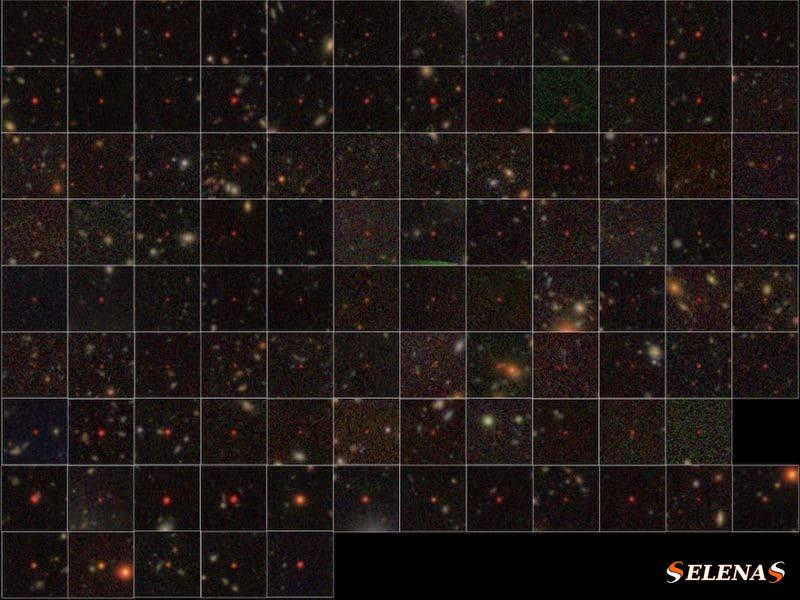

This dataset contains a total of 100 quasars, all of which were identified using data from the Hyper Suprime-Cam on the Subaru telescope. Among these 100 quasars, the top 7 rows include 83 newly discovered ones, while the bottom 2 rows consist of 17 quasars that were already known within the field of view.
Galaxies’ Early Stage: Quasars at Their Core
Scientists now have a new understanding of quasars, recognizing them as the exceptionally luminous cores of galaxies during their early development.
After extensive investigation spanning numerous years, these entities have been reclassified as quasars – a specific kind of active galactic nucleus, abbreviated as AGN.
Indeed, there exists a diverse range of AGNs, each with its own unique narrative waiting to be uncovered.
Theoretically, the immense radiation emanating from an AGN serves as fuel for the supermassive black hole situated at its core.
This radiation derives from matter within the accretion disk that envelops the black hole. The disk’s particles – including dust, gas, and various other substances – undergo countless collisions, generating intense friction and heating the disk to temperatures reaching millions of degrees.
The inward spiral of material in the accretion disk of an enormous black hole, specifically in the heart of a quasar, is the outcome of particles colliding and rebounding off each other, resulting in a loss of momentum.
This substance originated from the vast clouds of gas, primarily comprised of molecular hydrogen, that pervaded the cosmos during the early stages after the occurrence of the Big Bang.
Consequently, quasars positioned in the early universe possessed an extensive reservoir of material to consume.
As the material within the accretion disk of a quasar/black hole becomes hotter, it emits radio waves, X-rays, ultraviolet radiation, and visible light.
The quasar becomes so luminous that it can outshine entire galaxies.
However, it is important to note that quasars are located at tremendous distances from us.
They are situated so far away that we can only observe the active core or nucleus of the galaxy in which they reside.
Imagine spotting a car’s headlights in the darkness of the night. You can’t determine the make or model of the car, as everything else is obscured by darkness.
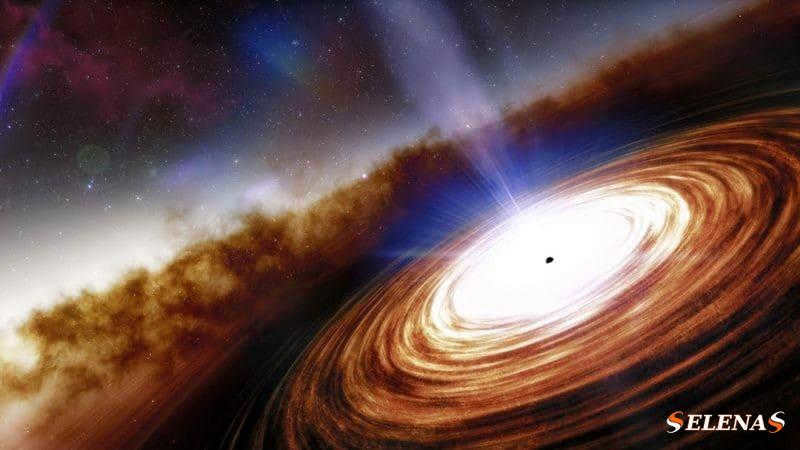

A visual representation of quasar “J0313-1806”, the most remote quasar currently known. Quasars are exceptionally luminous entities in the early stages of the Universe that are believed to have been fueled by supermassive black holes. This depiction showcases a wide accretion disk encircling a black hole and portrays the incredibly fast wind, blowing at approximately 20% of the speed of light, observed near “J0313-1806”.
Seyfert galaxies
However, there exist galaxies that do not fall into the category of quasars, yet possess luminous active nuclei where the remainder of the galaxy is observable.
An instance of such an active galactic nucleus is the Seyfert galaxy, which derives its name from the renowned astronomer Carl Keenan Seyfert, who was the first to discover them.
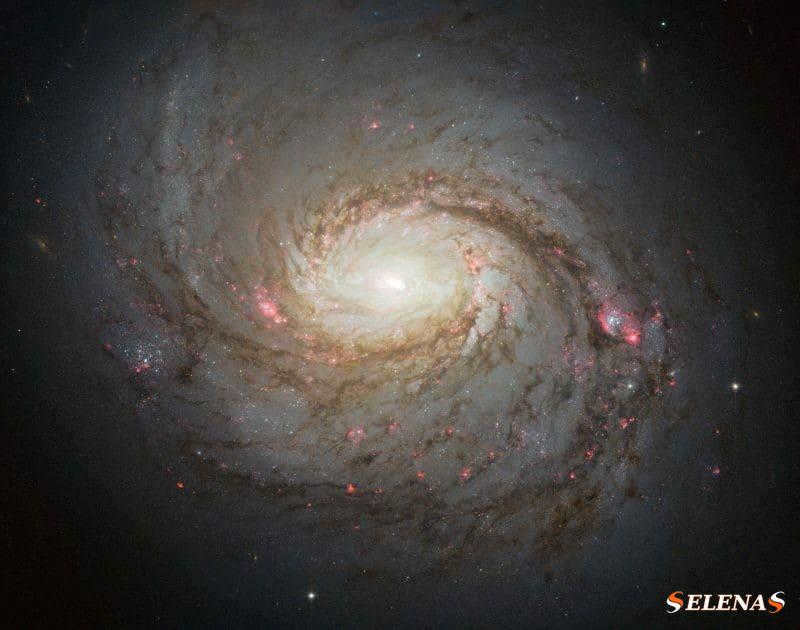
NGC 1068 (Messier 77) was one of the first Seyfert galaxies to be classified. It is the brightest and one of the closest, most extensively studied type 2 Seyfert galaxies, serving as the prototype for this category. This image was captured by the Hubble Space Telescope in 2013.
Seyfert galaxies comprise approximately 10% of all galaxies in the Universe.
They are distinct from quasars due to their relatively young age and well-defined structure.
Galaxies housing quasars are in their early stages of development and lack a definitive form.
However, consider the immense amount of energy required to illuminate an object to the point where it becomes visible in radio waves, even from the farthest corners of the universe.
Quasars have the ability to emit an amount of energy that is a thousand times greater than the combined brightness of the approximately 200 billion stars within our Milky Way galaxy.
A typical quasar is significantly brighter than our Sun, with a brightness that is 27 trillion times greater!
Imagine if we were to replace the Sun in our sky with a quasar. The immense brightness of the quasar would instantly blind anyone who foolishly looked directly at it.
If a quasar were to be placed at the same distance as Pluto, it would cause all of Earth’s oceans to rapidly turn into steam in just one-fifth of a second.
Evolution of galaxies in the universe
Astronomical experts posit that the majority, if not all, of large galaxies underwent a phase called the “quasar phase” during their early stages, shortly after their formation.
If this hypothesis holds true, then the luminosity of these galaxies would have diminished once they exhausted their supply of matter to fuel the accretion disk surrounding their supermassive black holes.
Subsequently, these galaxies entered a dormant state, with their central black holes lacking any material to consume.
However, observations have revealed that the black hole situated at the core of our own galaxy experiences brief flares when it encounters incoming material, resulting in the emission of radio waves and X-rays.
It is entirely plausible that a black hole has the capability to tear apart entire stars and engulf them as they cross its event horizon, which marks the point of no return.
However, it should be noted that our understanding of the development of galaxies – from a youthful quasar to a mature, settled galaxy – remains incomplete.
Galaxies often present us with anomalies, and a prime example can be found in our own Milky Way.
We now have knowledge, for instance, that approximately 3.5 million years ago, a massive explosion occurred at the core of our galaxy, referred to as the Seyfert flare.
This event seems to have originated from Sagittarius A*, the supermassive black hole at the heart of the Milky Way, resulting in the formation of two enormous lobes of intensely heated plasma that extend approximately 25,000 light-years from the northern and southern galactic poles.
These immense lobes are known as Fermi bubbles to scientists and can be observed today in the gamma-ray and X-ray spectra (which encompass high-frequency electromagnetic radiation).
Therefore, astronomers continue to investigate the idiosyncrasies of galaxy evolution.
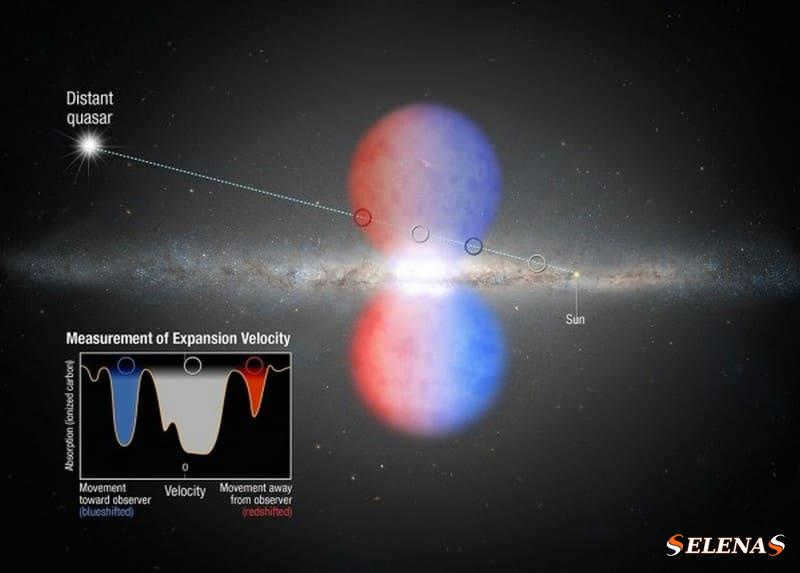
An artist’s depiction of the remarkable Fermi bubbles that were discovered in 2010. These enormous lobes stretch both above and below the plane of our own Milky Way galaxy. Emitting gamma rays and X-rays, they cannot be seen by the naked eye. The illustration illustrates how the Hubble Space Telescope was used to examine the light emitted by a distant quasar in order to investigate the Fermi bubbles. As the light passed through one of these bubbles, it recorded valuable information about the temperature, composition, and ultimately the mass. This demonstrates that quasars are not only enigmatic but also beneficial in scientific research!
Discovery of Quasars: A Challenging Journey
The journey of discovering quasars has been far from easy for astronomers.
In fact, it was in the late 1950s when astronomers, armed with radio telescopes, first stumbled upon these enigmatic celestial objects.
These objects, which emitted radio waves and had a star-like appearance, were dubbed quasi-stellar radio objects.
Interestingly, they remained invisible to optical telescopes, despite their star-like resemblance, brightness, and small angular diameter.
Hence, astronomers of that time assumed that they were observing objects within our own galaxy.
However, further analysis of the radio spectra of these objects revealed a level of mystery that exceeded all expectations.
John Bolton, a British-Australian astronomer, played a significant role in the early observations of quasars, including the discovery of the first two quasars, known as “3C48” and “3C273,” in the early 1960s.
He and his colleagues were perplexed by the fact that quasars couldn’t be observed through optical telescopes.
Their goal was to discover “optical analogs” of quasars – quasars that could be seen with their own eyes through a telescope, rather than just through radio instruments.
At the time, astronomers were unaware that quasars were actually incredibly distant, too far away for their optical counterparts to be visible from Earth, despite being inherently bright objects.
However, in 1963, astronomers Allan Sandage and Thomas A. Matthews finally found what they had been searching for: a faint blue star in the exact location of a known quasar.
It appeared to be unlike anything they had ever encountered before.
Unfortunately, there was nothing they could do to change the situation.
After that, Bolton and his team utilized the 200-inch (5-meter) Hale telescope to examine the quasar known as “3C273” as it moved behind the Moon.
These observations also enabled them to acquire spectra.
Once again, the spectra appeared peculiar, displaying unfamiliar emission lines.
These lines provide astronomers with information about the chemical elements present in the object under investigation.
However, the quasar’s spectral lines were nonsensical and seemed to suggest the presence of elements that shouldn’t be there.

The hydrogen spectrum of quasar 3C273. The emission lines are shifted towards longer wavelengths, indicating that the quasar is located at a significant distance from us. This observation led astronomer Maarten Schmidt to propose that the emission lines were actually normal hydrogen emission lines that had been heavily redshifted.
After studying the unusual emission lines in quasar spectra, Schmidt concluded that the redshift was a result of the quasar’s extreme distance from Earth.
Thus, the mystery of the redshift in quasar spectra was solved, with the explanation being the immense distance of these celestial objects.
How far are they from us?
However, if quasars were actually located at the outer reaches of the observable Universe, how could they possibly produce such immense amounts of energy?
As far back as 1964, the very existence of black holes was a topic of heated debate.
Many scientists dismissed them as mere mathematical oddities, as they seemed impossible to exist in the physical universe.
Thus, the discussion regarding the true nature of quasars continued until the 1970s, when a new generation of ground-based and space-based telescopes provided irrefutable evidence that quasars are indeed situated at vast distances, allowing us to witness galaxies in their early stages of development and confirming that the quasar phase is a natural part of their evolution.
With the newfound recognition of black holes, astronomers have now had the opportunity to simulate the core of the mind-boggling energy source driving quasars: supermassive black holes that consume vast quantities of gas and subsequently release immense amounts of energy across the entire electromagnetic spectrum.
This simulation provides an explanation for the positioning of quasars near the outer reaches of the observable Universe and the absence of their presence closer to us: quasars are youthful galaxies that are observed soon after their birth in the early stages of the Universe.
Quasars: an Ongoing Enigma
While significant progress has been made in the study of quasars and active galactic nuclei, there is still a great deal that eludes our understanding.
However, I believe that part of our limited comprehension stems from a lack of imaginative thinking.
The sheer magnitude of energy produced by the black hole engines at the cores of quasars, those enigmatic entities lurking in the darkness, is nearly unfathomable.
Similarly, comprehending the vast distances that separate us from them proves to be an equally challenging task.
Yet, we cannot blame ourselves entirely for this predicament: our cognitive capacities are simply ill-equipped to grapple with such abstract concepts.
Quasars serve as a prime example of cosmic creatures in the celestial menagerie that we should acknowledge without seeking complete understanding.
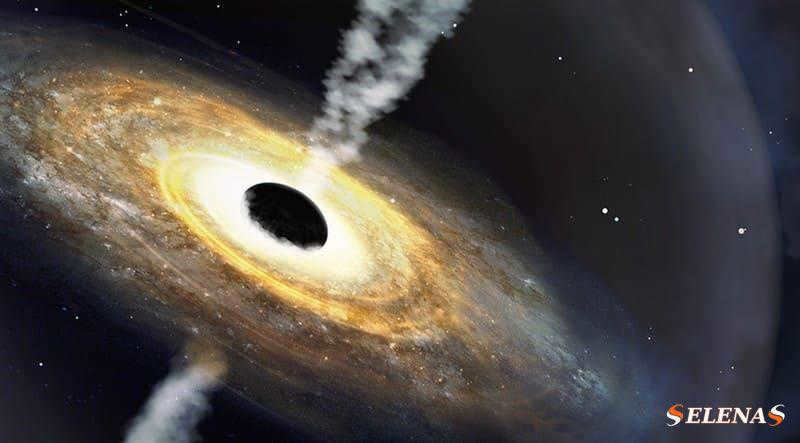
An artist’s depiction of the Poniua’ena (Poniua’ena) quasar, the first quasar to be given a Native Hawaiian name.
In summary, quasars are incredibly bright and incredibly distant entities.
It is believed that their immense energy output is connected to activity surrounding a central supermassive black hole in young galaxies located near the outer limits of the observable universe.
If you have any further inquiries or wish to share your thoughts on this article, please feel free to do so in the comments section below.
Until next time! Come on in!

Quasars, which are among the most luminous entities in the detectable cosmos, could potentially be the most potent reservoirs of energy.
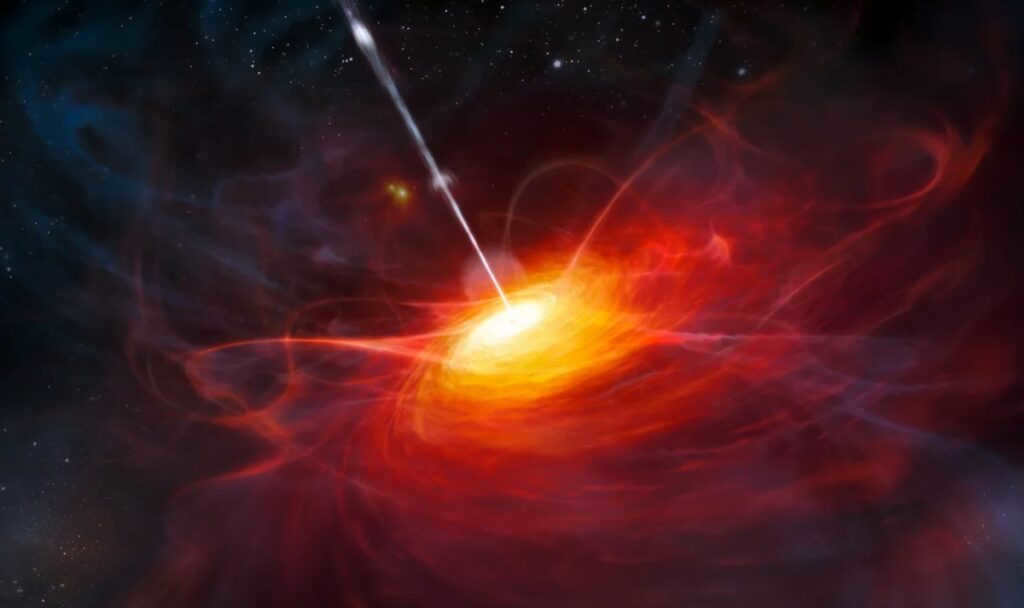

Ever since their discovery in the 1960s, over 7,000 quasars have been found, but scientists estimate that there are tens of millions of similar objects in the observable part of the Universe, and available technology will assist in their detection.
The term “quasar” (quasar) is a combination of the words quasi-stellar (star-like) and radiosource (radio source), which essentially means “star-like radio source”. However, it is now known that there are also quasars that do not exhibit much activity in the radio spectrum.
Displacement
Redshift is a remarkable characteristic of quasars. It is caused by the Doppler effect. The phenomenon of spectral lines shifting towards the red end of the spectrum implies that the object is receding from the observer at an incredibly high velocity. This attribute was initially observed by Martin Schmidt, a Dutch astronomer, in 1963. It enabled him to calculate the distance between quasars and the Earth.
Distance
If the rate at which quasars are moving away from Earth is connected to the expansion of the Universe (which is generally accepted), then according to Edwin Hubble’s law, it can be inferred that quasars should currently be located at a significant distance from us.

It has been proven that quasars are located at a distance of more than 10 billion light years, and they are observed from Earth while moving at a speed close to the speed of light.
Unlike quasars, some of the furthest known galaxies are relatively closer to Earth and are moving away at a slower pace, which is several times slower than the speed of quasars. This observation serves as evidence that objects farther away from us are moving away at a faster rate than objects that are closer.
Observation
Observing a quasar in the night sky is not feasible and would require the use of an observatory. This raises the question: how is it possible that quasars, being among the brightest objects, cannot be seen with the naked eye? The answer lies in their immense distance from Earth.
Size and Lifespan
Due to their incredibly high speeds, the brightness of a quasar observed can change in a matter of days. However, decades of collected data have allowed scientists to make some conclusions about these celestial objects. It is known that quasars are relatively compact in size, and their dimensions can be comparable to those of the solar system.
Quasars typically exist for a duration of multiple million years due to the immense energy required to sustain their luminosity. Once their supply of “fuel” is depleted, the subsequent events remain uncertain, as the demise of quasars has yet to be observed.
Illustration of a quasar
The primary energy source of a quasar originates from the gravitational field of a supermassive black hole, which engulfs anything that ventures too near.
Quasars, enigmatic celestial bodies, are still not fully understood, with numerous hypotheses surrounding their origin. The emergence of quasars, their fate at the end of their life cycle, and the possibility of a quasar appearing in the Milky Way all remain unanswered questions.
Thus, it is imperative to continue the study of quasars, gathering diverse data to draw objective conclusions and potentially even predict the future, at least within the realms of our own galaxy.
The vast expanse of the universe holds countless wonders, often surpassing the boundaries of even the most imaginative science fiction. Today, we delve into the realm of distant objects in space, both real and imagined, which have captivated the collective imagination but still elude comprehension for many.
Red giant
Stars come in many different varieties: some are hotter, others cooler, some are larger, while others are conventionally considered smaller. A red giant star, for example, has a relatively low surface temperature but a massive radius. This combination gives it an incredibly high luminosity. In fact, a red giant can have a radius of up to 800 times that of our Sun and shine with a brightness that exceeds the Sun’s by a factor of 10,000. Notable red giants in the night sky include Aldebaran, Arcturus, and Hakruks, which are among the brightest lights visible. However, red giants are not the most massive stars. That distinction belongs to red supergiants, which can have a radius exceeding 1,500 times that of the Sun.
A red giant marks the end of a star’s life cycle. It occurs when a star exhausts all of its hydrogen fuel in its core and begins to burn helium at the outer edge of the core. As a result, red giants share a common structure consisting of a dense and hot core surrounded by a thin and extended shell. This transformation causes the star to increase in luminosity, expand its outer layers, and cool down its surface temperature. Additionally, the star emits a powerful stellar wind, expelling matter into the surrounding interstellar space.
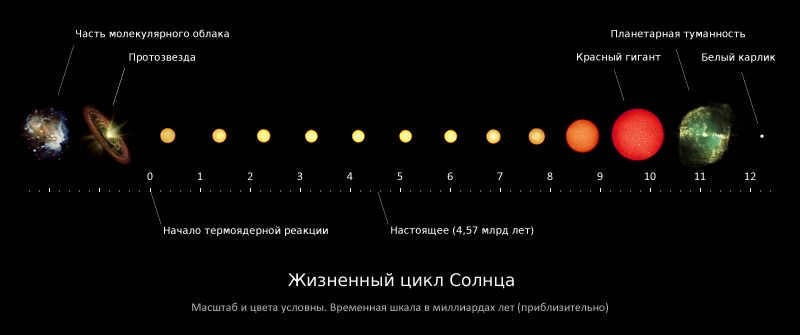
The future destiny of a red giant relies upon its mass. If the mass is low, the star will undergo a transformation into a white dwarf, while if it is high, it will become a neutron star or a black hole.
White dwarf
A dwarf star is the antithesis of a giant star. Before us, there is an evolved celestial body, whose mass is comparable to that of the Sun. The radius of white dwarfs is approximately 100 times smaller than the radius of our own celestial body. They are “born” when red giants shed their outer layers, which disperse into the interstellar space as a planetary nebula. The remaining cold and almost non-radiating core, primarily composed of helium, is known as a white dwarf.
White dwarfs make up 3-10% of the stellar population in our Galaxy, but they are challenging to identify due to their low luminosity. A white dwarf that is considered “old” is no longer directly white. The term “white dwarf” originates from the color of the first stars of this type that were discovered, like Sirius B (which, interestingly enough, can be approximately the same size as our Earth). In reality, a white dwarf is not a star because it no longer undergoes thermonuclear reactions in its core. To put it simply, a white dwarf is not a star, but rather its “remains”.
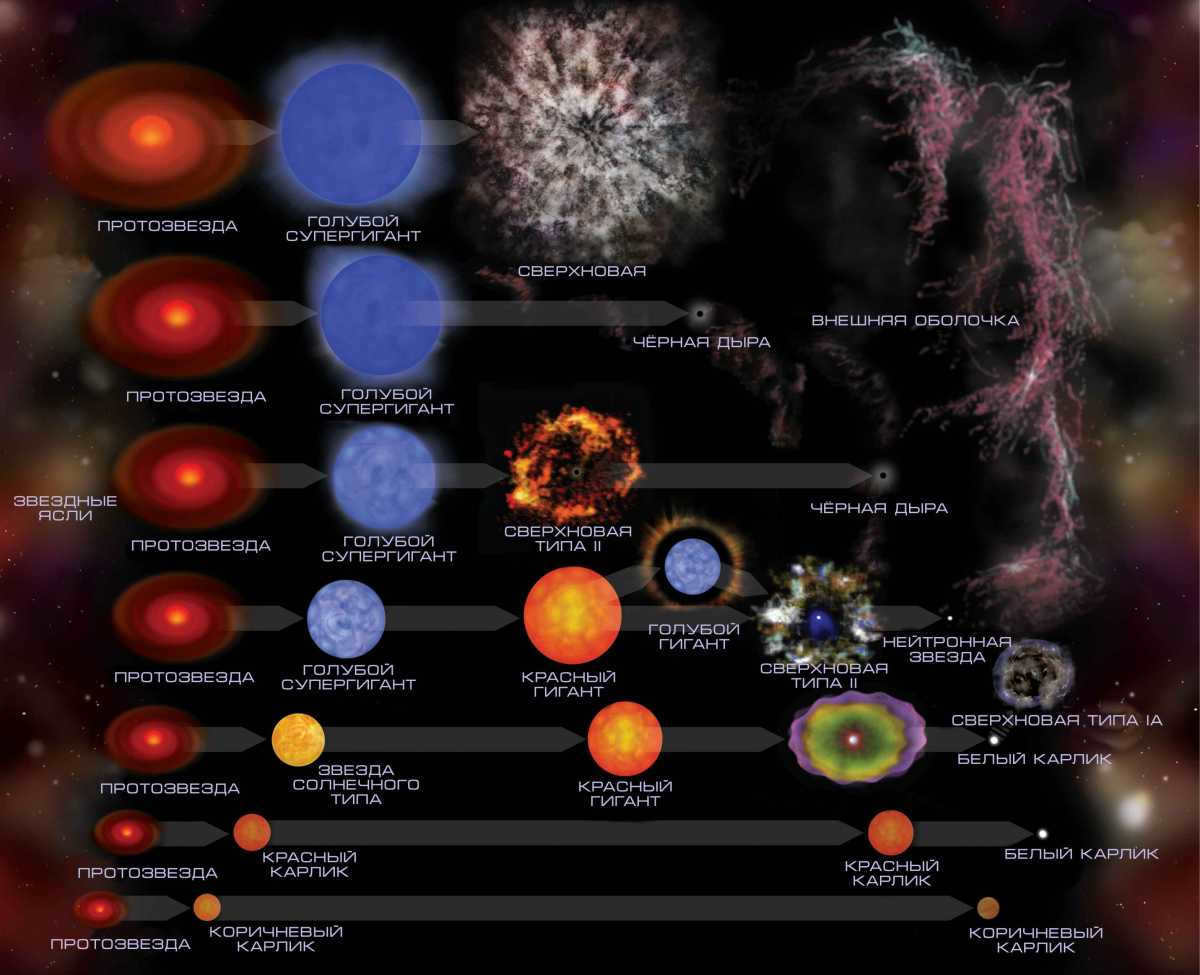
As the white dwarf continues to evolve, it cools down even further, leading to a transition in color from white to red. Eventually, it reaches its final stage of evolution as a cooled black dwarf. Alternatively, another possibility is for the white dwarf to accumulate matter on its surface that is “flowing” from another star, resulting in compression and the eventual explosion of a new star or supernova.
Yellow dwarf
Not everyone is acquainted with this category of star. And it is peculiar, for the reason that our own Sun is a representative example of a typical yellow dwarf. Yellow dwarfs are compact stars, with a mass ranging from 0.8 to 1.2 times that of the Sun. They belong to the group of stars known as the main sequence. In the Hertzsprung-Russell diagram, this is the area that encompasses stars that utilize the thermonuclear fusion of helium from hydrogen as a means of generating energy.
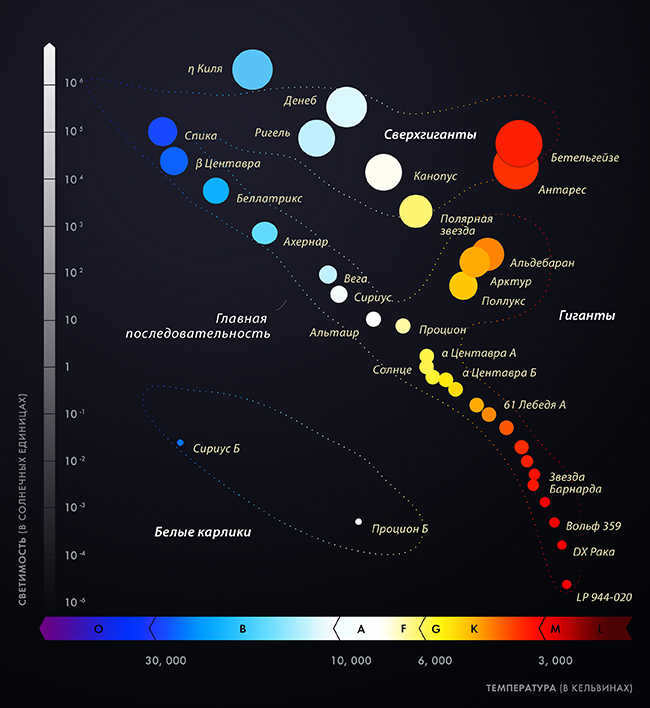
Stars known as yellow dwarfs have a surface temperature ranging from 5000 to 6000 K and an average lifespan of 10 billion years. Once their hydrogen fuel is depleted, these stars undergo a transformation and become red giants. Our own Sun is expected to face a similar fate in approximately 5-7 billion years, when it will expand and engulf our planet, eventually becoming a white dwarf. However, well before these events occur, life on Earth will be completely destroyed.
Brown dwarf
A brown dwarf, also known as a brown dwarf star, is a highly unique celestial object that exhibits a dark red or even infrared color, making it challenging to categorize using traditional classifications. It holds an intermediate position between a star and a gas giant planet. Brown dwarfs possess a mass ranging from 1-8% of the mass of our Sun. Their mass is too substantial for them to be considered as planets, and their gravitational compression enables them to undergo thermonuclear reactions involving elements that are considered “lightly combustible.” However, the mass of a brown dwarf is insufficient to trigger the fusion of hydrogen, resulting in a relatively short lifespan compared to a typical star.
Both in the protoplanetary disk of a star and independently of other cosmic objects, brown dwarfs have the potential to form. Planets can also emerge in their vicinity, and there is even speculation that these planets could support life. However, due to the limited heat and short lifespan of brown dwarfs, their habitable zone is situated relatively close to them and dissipates rapidly. While it took approximately 3.5 billion years for multicellular life to develop on Earth, and under favorable conditions it has the potential to exist for a significant period of time, the existence of multicellular life on a similar planet near a brown dwarf with a mass of 0.04 solar masses would be limited to no more than 0.5 billion years. As the brown dwarf cools, the habitable zone will gradually shift towards it, resulting in the extinction of all life on the planet.
Twin star
A twin star (or binary system) is a pair of stars that are gravitationally bound and revolve around a shared center of mass. While the concept of a twin star may seem extraordinary, it is actually quite prevalent within the Milky Way galaxy. It is estimated that roughly half of all stars in our galaxy are part of binary systems. In some instances, these systems can even consist of three stars.
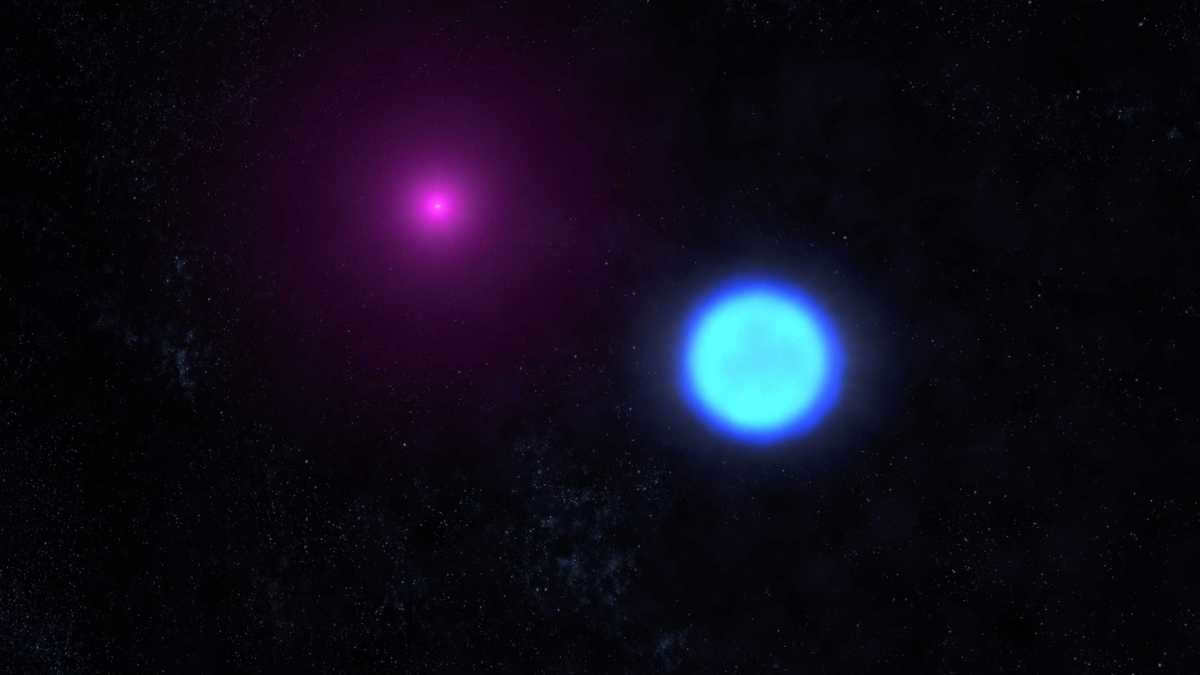
A typical star is created when a molecular cloud collapses under the influence of gravitational instability. However, when it comes to double stars, scientists have yet to agree on the exact reason for their separation.
Supernova
A supernova is a powerful and explosive event that occurs at the end of a massive star’s life. It is characterized by a sudden and dramatic increase in brightness, often outshining an entire galaxy for a brief period of time. The energy released during a supernova is immense, and it can be seen from billions of light-years away.
During a supernova, the star’s core collapses under its own gravity, causing it to become extremely dense. This process releases an enormous amount of energy, which is emitted as a burst of light and other forms of radiation. The explosion also releases heavy elements into space, which are then dispersed throughout the galaxy and can eventually become part of new stars and planets.
Supernovae play a crucial role in the life cycles of galaxies. They are responsible for the production and distribution of many elements necessary for life, such as carbon, oxygen, and iron. Without supernovae, the universe would lack the building blocks necessary for the formation of planets, and life as we know it would not exist.
Scientists study supernovae to better understand the processes that occur in stars and galaxies. By observing and analyzing the light emitted during a supernova, researchers can gain valuable insights into the physics of these explosive events. This knowledge can help us better understand the evolution of the universe and the formation of galaxies.
In conclusion, supernovae are fascinating and awe-inspiring phenomena that have a profound impact on the universe. They are not only responsible for the creation of heavy elements, but also for shaping the galaxies we see today. By studying supernovae, scientists are able to unravel the mysteries of the cosmos and gain a deeper understanding of our place in the universe.
Hydrogen has been observed in the spectrum of type II supernovae, leading to the inference that these explosions originate from a “conventional” star. When the “fuel” in a star with a mass greater than 10 solar masses is depleted, its core can become critically massive and undergo collapse. Consequently, the core of a Type II supernova ultimately transforms into a neutron star. These particular supernovae exclusively occur within spiral galaxies.
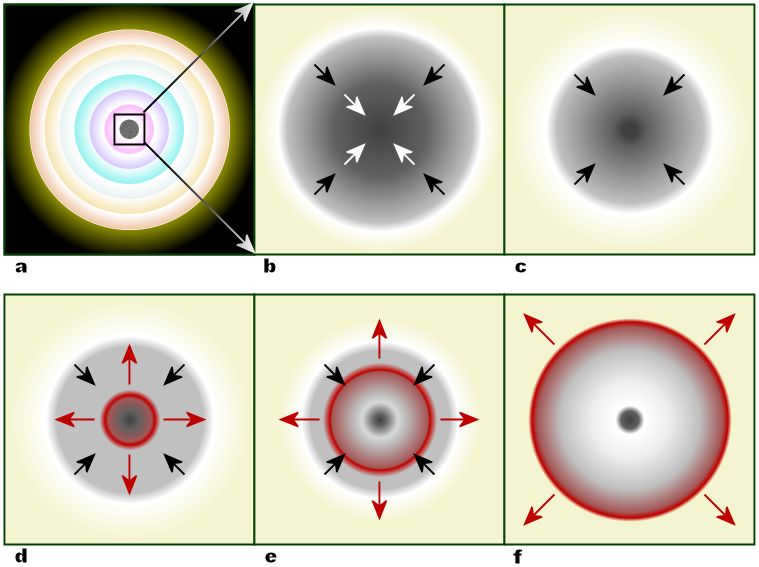
What is a Quasar in Simple Terms?
A quasar is a celestial object that emits enormous amounts of energy. It is believed to be powered by a supermassive black hole at the center of a galaxy. The energy is generated as matter falls into the black hole and forms an accretion disk. The intense gravitational forces cause the matter in the disk to heat up and emit radiation across the electromagnetic spectrum, including radio waves, infrared, visible light, ultraviolet, X-rays, and gamma rays.

Neutron stars are typically compact, with a radius that is usually less than 20 km. Most of these celestial objects have a mass of 1.3-1.5 times that of the Sun, although there are theoretical possibilities for neutron stars with a mass of up to 2.5 times that of the Sun. The density of a neutron star is incredibly high, to the point that a single teaspoonful of its matter would weigh billions of tons.
Pulsar
Pulsars are celestial objects known as neutron stars that emit pulses of radio, gamma-ray, optical, and X-ray radiation. These pulses are detected by scientific instruments. Unlike other stars, the rotation axis of a pulsar does not align with its magnetic field axis. As a result, the pulsar emits radiation only along its magnetic poles. Due to the rotation of the star, we can observe this radiation on Earth only when the pulsar’s magnetic pole faces our planet. This phenomenon can be likened to a lighthouse. From the shore, it appears to blink periodically, but in reality, it is simply the searchlight turning in a different direction. In simpler terms, we observe certain neutron stars as pulsars because one of their magnetic poles rotates towards the Earth.
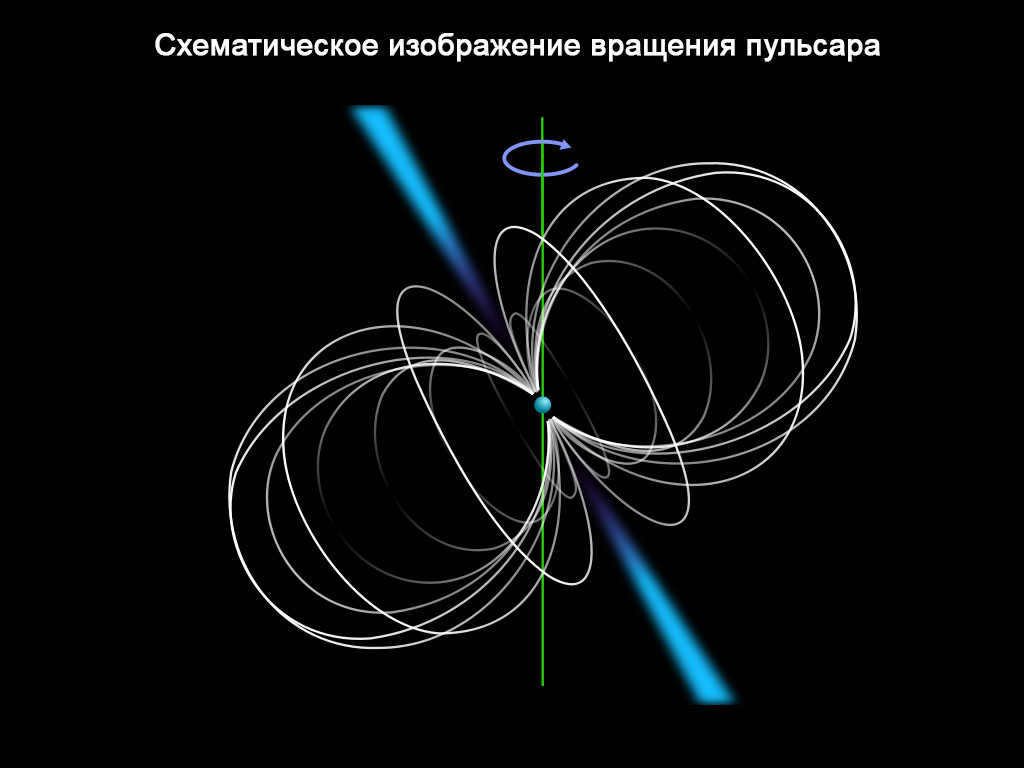
PSR 0531+21, situated in the Crab Nebula at a distance of 6520 light-years away, is the most extensively studied pulsar. This neutron star completes 30 rotations every second and possesses a total radiative power that is 100,000 times greater than that of the Sun. Nevertheless, there are still numerous aspects regarding pulsars that remain unexplored.
Quasar
Pulsar and quasar are often mistaken for each other, but they are actually quite different. A quasar is a fascinating entity that derives its name from the term “quasi-stellar radio source”. These objects are incredibly luminous and can be found at great distances from us. In fact, the radiation emitted by a quasar can surpass the combined brightness of all the stars within the Milky Way by a factor of a hundred.
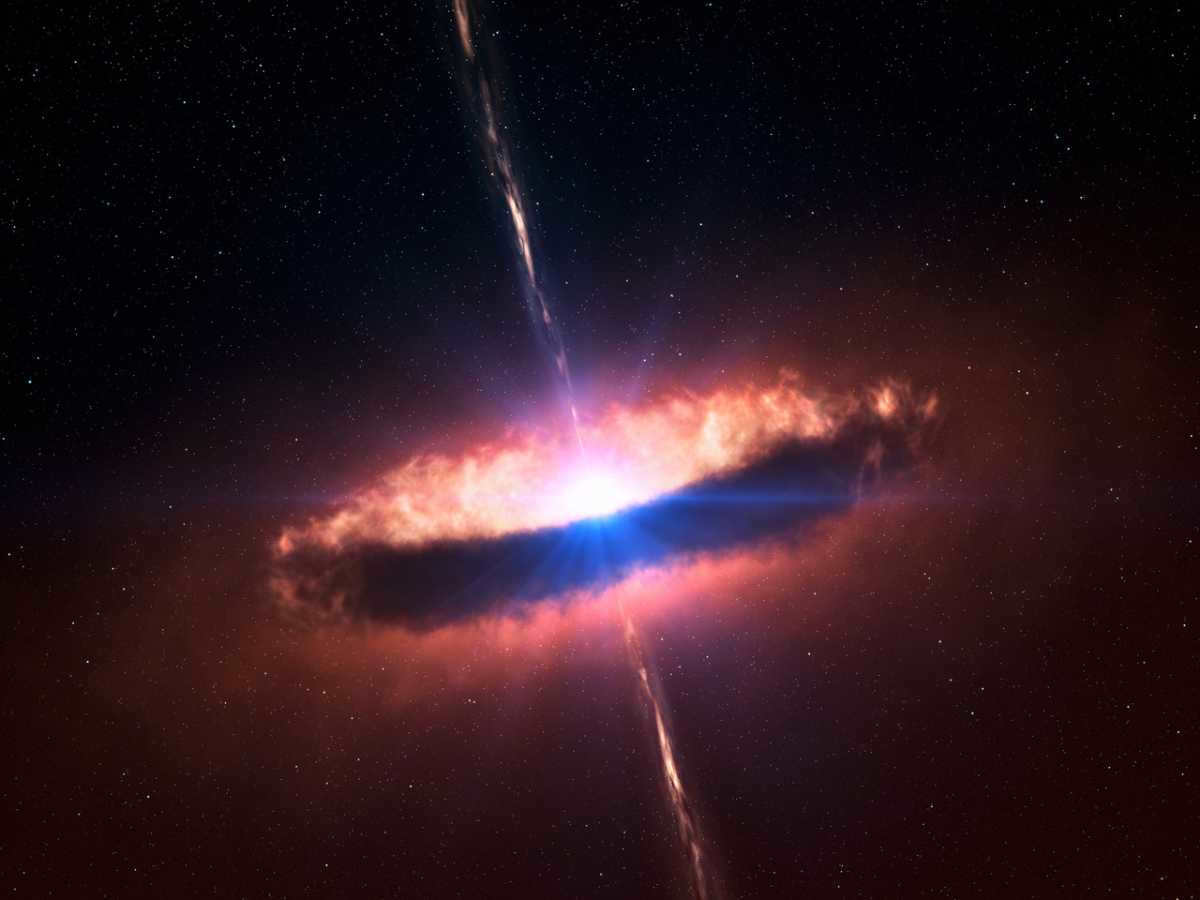
Undoubtedly, the detection of the initial quasar in 1960 ignited immense fascination in the phenomenon. Presently, researchers posit that a quasar represents the dynamic nucleus of a galaxy. Within this entity, lies a supermassive black hole, which gravitationally attracts matter from its surrounding space. The magnitude of this black hole is truly astronomical, and its emitted radiation surpasses the combined luminosity of all the stars within the galaxy. The nearest quasar to our location is situated 2 billion light-years away, while the farthest, owing to their extraordinary visibility, can be observed at a staggering distance of 10 billion light-years.
Blazars
Blazars are a type of quasar that emits incredibly powerful beams of plasma, known as relativistic jets, which can be observed from Earth. These jets originate from the core of the blazar and extend in opposite directions. The intense radiation and matter carried by these jets have the potential to obliterate any life in their path. If a beam like this were to pass within a distance of at least 10 light-years from Earth, it would result in the annihilation of all life on our planet.
The term “blazar” is derived from a combination of the words “quasar” and “BL Lizard.” The latter refers to a specific subtype of blazars known as lacertids. Lacertids are characterized by their optical spectrum, which lacks the broad emission lines typically seen in quasars.
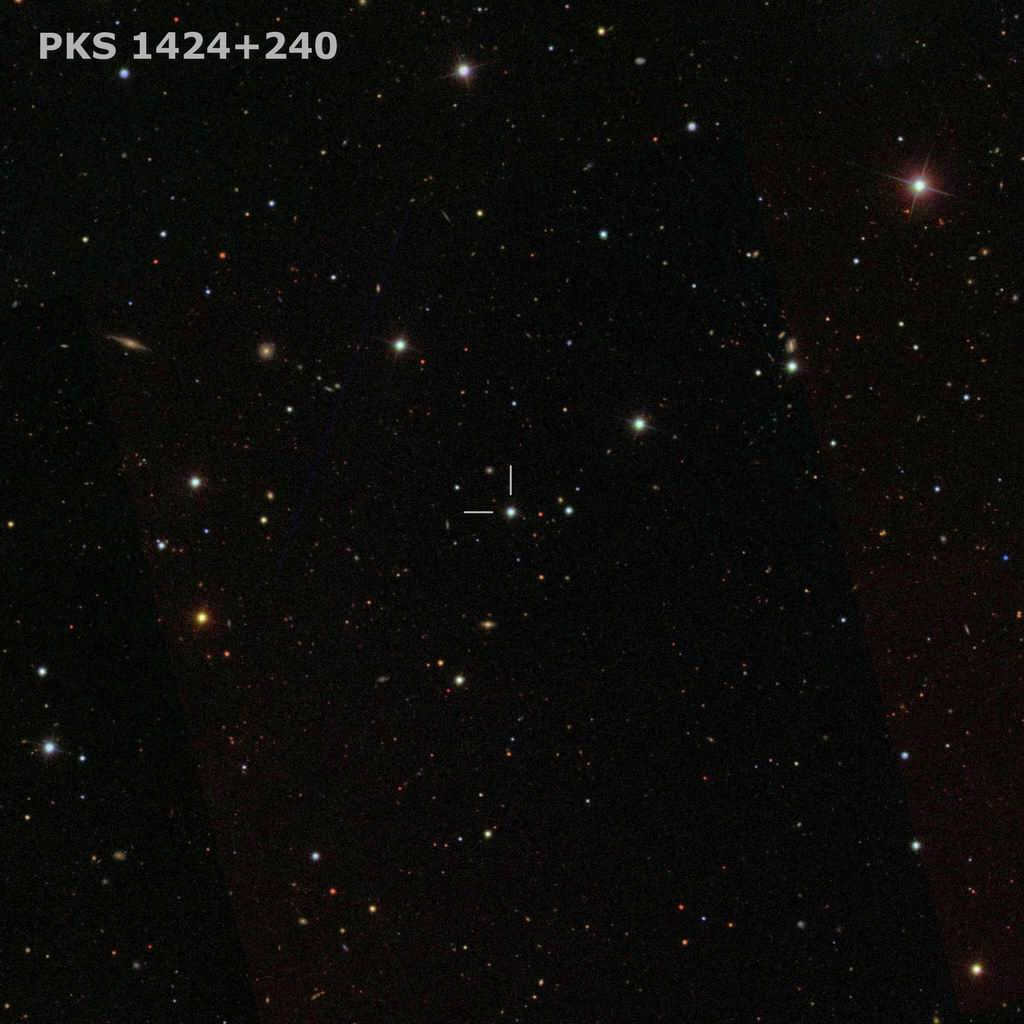
Scientists have recently determined the distance to the furthest blazar PKS 1424+240: it is approximately 7.4 billion light years away.
The enigma of a black hole
Undoubtedly, a black hole is one of the most perplexing entities in the vast expanse of the universe. Countless theories have been proposed to explain these enigmatic objects, yet their true nature remains elusive. Their escape velocity (the minimum speed required to overcome the gravitational pull of a celestial body) surpasses the speed of light! Nothing can evade the relentless gravitational force of a black hole. It is so gargantuan that it effectively halts the progression of time.
A black hole is created when a massive star exhausts its fuel and collapses under its own gravity, causing the space-time continuum to collapse with it. This collapse creates an incredibly strong gravitational field that prevents even light from escaping. Consequently, the region where the star once existed becomes a black hole. Essentially, a black hole is a curved segment of the universe that attracts nearby matter into its depths. Einstein’s theory of relativity is thought to hold the first clue to comprehending black holes. Nevertheless, the solutions to all fundamental queries remain unknown.
The mole hole
Continuing the discussion on this topic, it is simply impossible to ignore a purely speculative concept – the so-called mole holes, also known as wormholes. These are depicted as passages in space-time, consisting of two entrances and a narrow connection. A mole hole is a structural characteristic of space-time that, in theory, allows for the shortest possible travel. To grasp the essence of a wormhole, one can visualize it by rolling up a piece of paper (which represents our space-time) and then puncturing it with a needle. The resulting aperture would resemble a wormhole. While in our reality we can only move across the surface of the paper from one hole to another, in theory, it is possible to traverse the hole and instantaneously emerge on the other side!
Nebula
A nebula is simply a celestial cloud composed of particles of dust and gas. It serves as the fundamental component of our vast Universe, giving birth to stars and entire star systems. These ethereal formations are among the most visually captivating wonders of the cosmos, capable of radiating a brilliant spectrum of colors akin to a rainbow.

The Andromeda Nebula, also known as the Andromeda Galaxy, is the nearest galaxy to our own Milky Way. It is located approximately 2.52 million light years away from Earth and is significantly larger than our Galaxy, containing around 1 trillion stars. It is possible that in the distant future, humanity may be able to explore the Andromeda Nebula. However, even if this does not occur, the Nebula itself will eventually collide with and absorb the Milky Way in about 5 billion years.
It is important to clarify that the term “nebula” has a long history and in the past it could refer to various astronomical objects, including galaxies like the Andromeda Nebula. However, this practice is no longer used and the term “nebula” now specifically refers to clusters of dust, gas, and plasma.
Emission nebula, reflective nebula, dark nebula, and planetary nebula are types of nebulae. Emission nebulae are clouds of high temperature gas that emit their own radiation. Reflective nebulae do not emit their own radiation but reflect the light from nearby stars. Dark nebulae are clouds of dust that block light from objects located behind them. Planetary nebulae are shells of gas produced by stars at the end of their evolution. Additionally, nebulae can also include the remnants of supernovae.
Dark matter
Dark matter is a theoretical concept that lacks the ability to emit or directly interact with electromagnetic radiation. As a result, it cannot be observed directly. However, we can infer the existence of dark matter by studying the behavior of astrophysical objects and the gravitational effects they generate.

The discovery of dark matter came about through a process of calculating the total mass of the visible universe and studying gravitational indicators. This analysis revealed an imbalance that could only be attributed to the presence of a mysterious substance. Furthermore, observations showed that certain galaxies were rotating at speeds that defied the predictions of calculations. It became clear that something was exerting an influence on these galaxies, preventing them from “flying apart”.
Scientists now believe that dark matter is not composed of ordinary matter, but rather consists of minuscule exotic particles. However, there are some who doubt this theory and argue that dark matter could also be made up of macroscopic objects.
Dark energy is an enigma even greater than dark matter. While the concept of dark matter has been around for some time, dark energy is a relatively new idea that has completely upended our understanding of the universe. Scientists have concluded that dark energy is responsible for the accelerated expansion of our universe, causing it to expand at an increasingly rapid pace over time. According to the dark matter hypothesis, the distribution of mass in the universe is as follows: 74% dark energy, 22% dark matter, 0.4% stars and other celestial objects, and 3.6% intergalactic gas.
Unlike dark matter, which has at least some indirect evidence of its existence, dark energy exists solely within the confines of a mathematical model that explains the expansion of our universe. As a result, no one can definitively say what dark energy truly is at this point in time.
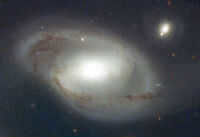
For alternative definitions of the term, please refer to the relevant sources.
The NGC 4319 galaxy and quasar is a type of celestial object that is among the most luminous in the observable Universe. Quasars, derived from the Latin term “quas(i)” meaning like or something like, combined with the English term “(st)ar” meaning star, are known as the active cores of galaxies. It is hypothesized that they contain supermassive black holes, which attract matter from their surrounding environment through the process of accretion. This leads to the formation of a massive black hole and the emission of intense radiation that surpasses the combined radiation output of all the stars within the galaxy. Recent investigations have revealed that the majority of quasars are situated near the central regions of enormous elliptical galaxies (source not specified, 3020 days).
The radiation output of a quasar can be tens or hundreds of times greater than the combined output of all the stars in galaxies like ours. Evidence of parent galaxies (quasars are believed to be the powerful and distant active cores of galaxies [source not provided for 3033 days] ) surrounding quasars (not all of them) was only discovered later.
Initially, quasars were identified as objects with significant redshift, emitting electromagnetic waves (including radio waves and visible light) and having such small angular sizes that they couldn’t be distinguished from “point sources” – stars – for several years after their discovery (in contrast, extended sources are more typical of galaxies [1] ; the brightness of the brightest star is -1.46, while the stellar magnitude of the brightest quasar is +12.6).
According to one hypothesis, quasars are thought to represent early-stage galaxies, where a supermassive black hole is absorbing surrounding matter [2] [3]. In recent times, it has been suggested that the radiation source of quasars is the accretion disk of a supermassive black hole located at the core of the galaxy. Consequently, the redshift of quasars is expected to be greater than the cosmological redshift by the amount of gravitational displacement predicted by A. Einstein in his general theory of relativity (GTR).
Quasars are often likened to the Universe itself. They can be observed from vast distances (up to a redshift slightly above z = 7) [4] [5] [6] [7]. Additionally, they are utilized for studying the spectral lines of hydrogen absorption that unfold into a complex array of lines at the redshift of the absorbing clouds [8].
Etymology [ ]
The English term quasar is derived from the words quasi-stellar (“quasi-stellar” or “star-like”) and radiosource [9].
Original definition [ ]
The original definition was formed in the late 1950s and early 1960s, at the time of the discovery of the first quasars and the beginning of their study. While this definition is generally correct, it has been found that there are radio quasars that do not produce strong radio emissions [10] [13]. As of 2004, approximately 90% of known quasars are classified as radio quasars.
History of Observations
The exploration of quasars began with a project conducted at the Jordell Bank Radio Observatory aimed at measuring the apparent angular sizes of radio sources.
Alan Sandidge and Thomas Matthews made a groundbreaking discovery in the late 1950s when they identified the first quasar, known as 3C 48, during a comprehensive radio survey of the sky. These quasars exhibit a redshift phenomenon. By recognizing that this redshift is a result of the cosmological redshift effect caused by the movement of quasars away from us, scientists were able to determine the distance to these celestial objects using Hubble’s law. This breakthrough occurred on April 9, 1963, when photometric measurements of the quasar images were made [14].
One of the closest and brightest quasars possesses a brightness of approximately 13 m [15] and a redshift value of z = 0.158 [16] (equivalent to a distance of roughly 3 billion light-years) [17]. The most remote quasars, thanks to their immense luminosity that surpasses hundreds of times the luminosity of regular galaxies, are detected by radio telescopes at distances exceeding 12 billion light-years. As of July 2011, the farthest quasar (ULAS J112001.48+064124.3) was situated approximately 13 billion light-years away from Earth [18]. The irregular changes in the brightness of the quasars on timescales less than one day indicate that the region where their radiation is generated has a small size comparable to the dimensions of the Solar System.
Properties [ ]
Quasars have an incredibly high luminosity, with the ability to emit energy in the range of 10^46 – 10^47 s [20]. Compared to our Sun, a quasar produces about 10 trillion times more energy per second, and even a million times more energy than the most powerful known star. Furthermore, quasars exhibit variable emission across all wavelengths [10].
Many quasars exhibit fluctuations in their brightness over short periods of time. This characteristic is considered to be one of the fundamental properties of quasars, with the shortest observed variation occurring with a period of approximately 1 hour and the maximum variation in luminosity reaching up to 25 times. This limitation is due to the finite size of the object responsible for the luminosity variations, which cannot exceed the speed of light.
The age of the oldest known quasar is estimated to be more than 13 billion years.
Quasars have the potential to cause the destruction of the galaxies in which they reside.
If the brightest quasar in the entire Universe were positioned at the center of the Milky Way, it would appear 4 times brighter than the Moon in the night sky.
Also, take a look at [ ]
Some additional information [ ]
- ↑Zasov A. V. V., Postnov K. A. Nuclei of galaxies. General. // General Astrophysics. – Fryazino: Vek 2, 2006. – VOL. 3. – P. 371. – 496 с. – ISBN 5-85099-169-7. (refer to ISBN ) (Verified on July 7, 2011)
- ↑ BBC: Supermassive black holes
- ↑ What are quasars?, 1985, p. 4.
- ↑ Warren S., Mortlock D., Venemans B., Simpson C., Hewett P., McMahon R. Photometry of the z=7.08 quasar ULAS J1120+0641 // Spitzer Proposals. Spitzer Proposals. – 2011, May. – № 80114. (Verified on July 7, 2011)
- ↑ "A luminous quasar at a redshift of z = 7.085" (2011). Nature474: 616-619. doi:10.1038/nature10159. (English).
- ↑ESO.Discovery of the most distant quasar. Astronomy Magazine (June 29, 2011). Accessed July 4, 2011.Archived from the original source on August 23, 2011. (English)
- ↑ Amos, Jonathan (June 30, 2011). "'Monster' powering cosmic signal". BBC News. Retrieved July 4, 2011.
- ↑ B. Stern. Gamma-ray bursts: the devastating events in our galaxy
- ↑ Quasars // Bolshaya Sovetskaya Encyclopedia (in 30 vol.) / A. M. Prokhorov. – 3rd ed. – M: Sov. Encyclopedia, 1973. – VOL. XI. – P. 564-565. – 608 p. (see ISBN )
- ↑ 10,010,110,2Stephen P. Maran. Astronomy for "dummies" = Astronomy for dummies. – M .: Publishing House "Williams", 2004. – P. 198-200. – 256 p. – ISBN 5-8459-0612-1. (see ISBN )
- ↑ Physical Encyclopedic Dictionary. – M .: Soviet Encyclopedia, 1984. (refer to ISBN )
- ↑The MKI and the discovery of Quasars. Jodrell Bank Observatory . Verified on November 23, 2006.Archived from the original source on August 23, 2011.
- ↑ Sandage A. The Existence of a Major New Constituent of the Universe: the Quasistellar Galaxies. – 1965. – Vol. 141. – p. 1560.
- ↑А. D. Chernin, L. N. Berdnikov, A. S. Rastorguev “Big Science Astronomy”
- ↑3C 273 (English) . NASA/IPAC extragalactic database. IPAC. Verified on June 6, 2011.Archived from the original source on August 23, 2011.
- ↑3C 273 . SIMBAD Astronomical Database. CDS. Verified on June 6, 2011.
- ↑Ian Nicholson. The book “Gravitation, Black Holes and the Universe” was published in Moscow by Mir in 1983. It has a total of 240 pages and can be found on page 155. (see ISBN )
- ↑Astronomers made a discovery of the most distant quasar in Russian. This information was checked on July 5, 2011. It is also available in the original source, which was archived on August 23, 2011.
- ↑In the research paper titled “Detection of Cosmic Magnification with the Sloan Digital Sky Survey”, authored by Scranton et al in 2005, the authors discuss the discovery of cosmic magnification.
- ↑The Physics of Space information can be found in the original source, which was archived on August 23, 2011.
Literature [ ]
- K. I. Kellermann The Discovery of Quasars // Bulletin of the Astronomical Society of India. Bulletin of the Astronomical Society of India. — 2013.
- Daucourt G. Understanding Quasars – K. Soviet School, 1985. – 131 p. (see ISBN )





